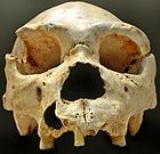
Miguelón
Encyclopedia

Homo heidelbergensis
Homo heidelbergensis is an extinct species of the genus Homo which may be the direct ancestor of both Homo neanderthalensis in Europe and Homo sapiens. The best evidence found for these hominins date between 600,000 and 400,000 years ago. H...
ever found. More than 5,500 human fossils of this species, which are considered to be the direct ancestor of Homo neanderthalensis, have been found in the Sima de los Huesos (The pit of bones) site in the Sierra de Atapuerca
Atapuerca
The Atapuerca Mountains is an ancient karstic region of Spain, in the province of Burgos and near Atapuerca and Ibeas de Juarros. It contains several caves, where fossils and stone tools of the earliest known Hominins in West Europe have been found. The earliest hominids may have dated to 1.2...
in northern Spain.
The excavators suggest that this concentration of bones in the pit may represent the practice of burial
Burial
Burial is the act of placing a person or object into the ground. This is accomplished by excavating a pit or trench, placing an object in it, and covering it over.-History:...
by the inhabitants of the cave. A competing theory cites the lack of small bones in the assemblage and suggests that the remains were washed into the pit by natural agents.
Miguelón, around thirty years old, had 13 impacts in the head and died of septicemia resulting from broken teeth. In his upper left jaw there is an important bone alteration, with evidence of alveolar infection. According to Arsuaga
Juan Luis Arsuaga
Juan Luis Arsuaga Ferreras obtained a master degree and a doctorate in Biological Sciences at the Universidad Complutense de Madrid, where he is professor in the Paleontology Department of the ....
, a tooth had been broken in life by a strong coup, so that the flesh had been exposed and led to an infectious process that continued until nearly the orbital bone
Orbit (anatomy)
In anatomy, the orbit is the cavity or socket of the skull in which the eye and its appendages are situated. "Orbit" can refer to the bony socket, or it can also be used to imply the contents...
.
The nickname Miguelón was derived from Miguel Indurain
Miguel Indurain
Miguel Ángel Indurain Larraya is a retired Spanish road racing cyclist. He won five consecutive Tour de Frances from 1991 and 1995, the first to do so, and the fourth athlete to win five times. He won the Giro d'Italia twice, becoming one of only seven people in history to achieve the Giro Tour...
, a retired Spanish road racing cyclist that won the Tour
1992 Tour de France
The 1992 Tour de France was the 79th Tour de France, taking place July 4 to July 26, 1992. The total race distance was 21 stages over 3983 km, with riders averaging 39.504 km/h...
and Giro
1992 Giro d'Italia
The 1992 Giro d'Italia of cycling, the 75th edition of the race, was held from 24 May to 14 June 1992. It covered a total of 3,835 km, in 22 stages, completed at an average speed of 37.017 km/h...
in 1992, the year in which this skull was discovered.
See also
- List of human fossils
- List of hominina (hominid) fossils (with images)
External links
- Human Fossils - The pit of bones (in Spanish)

